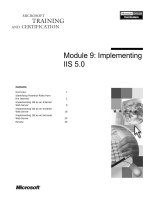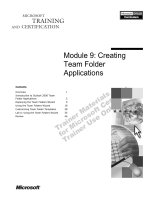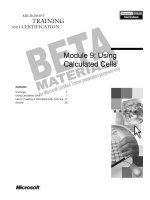Tài liệu Module 9: Introduction to Programming Objects doc
Bạn đang xem bản rút gọn của tài liệu. Xem và tải ngay bản đầy đủ của tài liệu tại đây (931.68 KB, 36 trang )
Contents
Overview 1
Displaying the Text of
a Programming Object 2
Introduction to Views 4
Advantages of Views 6
Creating Views 7
Introduction to Stored Procedures 12
Introduction to Triggers 15
Introduction to User-defined Functions 16
Recommended Practices 21
Lab A: Working with Views 22
Review 28
Module 9: Introduction
to Programming Objects
Information in this document is subject to change without notice. The names of companies,
products, people, characters, and/or data mentioned herein are fictitious and are in no way intended
to represent any real individual, company, product, or event, unless otherwise noted. Complying
with all applicable copyright laws is the responsibility of the user. No part of this document may
be reproduced or transmitted in any form or by any means, electronic or mechanical, for any
purpose, without the express written permission of Microsoft Corporation. If, however, your only
means of access is electronic, permission to print one copy is hereby granted.
Microsoft may have patents, patent applications, trademarks, copyrights, or other intellectual
property rights covering subject matter in this document. Except as expressly provided in any
written license agreement from Microsoft, the furnishing of this document does not give you any
license to these patents, trademarks, copyrights, or other intellectual property.
2000 Microsoft Corporation. All rights reserved.
Microsoft, BackOffice, MS-DOS, PowerPoint, Visual Studio, Windows, Windows Media, and
Windows NT are either registered trademarks or trademarks of Microsoft Corporation in the
U.S.A. and/or other countries.
The names of companies, products, people, characters, and/or data mentioned herein are fictitious
and are in no way intended to represent any real individual, company, product, or event, unless
otherwise noted.
Other product and company names mentioned herein may be the trademarks of their respective
owners.
Project Lead: Cheryl Hoople
Instructional Designer: Cheryl Hoople
Technical Lead: LeRoy Tuttle
Program Manager: LeRoy Tuttle
Graphic Artist: Kimberly Jackson (Independent Contractor)
Editing Manager: Lynette Skinner
Editor: Wendy Cleary
Editorial Contributor: Elizabeth Reese
Copy Editor: Bill Jones (S&T Consulting)
Production Manager: Miracle Davis
Production Coordinator: Jenny Boe
Production Tools Specialist: Julie Challenger
Production Support: Lori Walker (S&T Consulting)
Test Manager: Sid Benavente
Courseware Testing: Testing Testing 123
Classroom Automation: Lorrin Smith-Bates
Creative Director, Media/Sim Services: David Mahlmann
Web Development Lead: Lisa Pease
CD Build Specialist: Julie Challenger
Online Support: David Myka (S&T Consulting)
Localization Manager: Rick Terek
Operations Coordinator: John Williams
Manufacturing Support: Laura King; Kathy Hershey
Lead Product Manager, Release Management: Bo Galford
Lead Product Manager: Margo Crandall
Group Manager, Courseware Infrastructure: David Bramble
Group Product Manager, Content Development: Dean Murray
General Manager: Robert Stewart
Module 9: Introduction to Programming Objects iii
Instructor Notes
This module describes how to create programming objects that enable the user
to view and manipulate data while hiding the complexity of the underlying
database structure. The module introduces these programming objects—views,
stored procedures, triggers, and user-defined functions—and describes the
advantages of using them.
At the end of this module, students will be able to:
!
Display the text of a programming object.
!
Describe the concept of views.
!
List the advantages of using views.
!
Create views.
!
Describe stored procedures.
!
Describe triggers.
!
Describe user-defined functions.
Materials and Preparation
Required Materials
To teach this module, you will need the following materials:
!
Microsoft
®
PowerPoint
®
file 2071A_09.ppt.
!
The C:\Moc\2071A\Demo\Ex_09.sql example file contains all of the
example scripts from the module, unless otherwise noted in the module.
Preparation Tasks
To prepare for this module, you should:
!
Read all of the materials.
!
Complete the lab.
Presentation:
60 Minutes
Lab:
30 Minutes
iv Module 9: Introduction to Programming Objects
Module Strategy
Use the following strategy to present this module:
!
Displaying the Text of a Programming Object
Introduce the sp_helptext system stored procedure.
!
Introduction to Views
Introduce the concept of views. Point out that views are simply stored
queries.
!
Advantages of Views
List the advantages of using views.
!
Creating Views
Views provide the ability to store a predefined query as an object in the
database for later use. They offer a convenient way to hide sensitive data or
the complexities of a database design and to provide a set of information
without requiring the user to write or execute Transact-SQL statements.
Discuss how to create, alter, and drop views. Emphasize the importance of
testing the statement that creates the view prior to creation of the view itself.
Cover the restrictions and guidelines that users must consider. Describe how
users can encrypt the view definition. List the system tables that contain the
view definition information.
!
Introduction to Stored Procedures
Note that this topic introduces stored procedures and describes how to use
stored procedures to improve application design and performance by
encapsulating business rules to process common queries and data
modifications. Point out that this topic discusses what stored procedures are
and the advantages of using them. Emphasize that this topic does not
attempt to comprehensively address stored procedures.
Introduce the elements of a stored procedure. Note that students have
executed system stored procedures throughout the course, so they should be
familiar with how they work. Emphasize that the primary focus of this topic
is on creating stored procedures that are defined in a user’s local database.
Discuss how stored procedures are processed in order to explain why they
execute faster than batches. Contrast stored procedure performance with the
way that batches are processed. Highlight the advantages of stored
procedures to point out why students would want to create them in their
applications.
!
Introduction to Triggers
Triggers are useful tools for database implementers who want certain
actions to be performed whenever data in a specific table is inserted,
updated, or deleted. The goal of this section is to promote awareness of
triggers and is intended only as an introductory overview.
Define triggers. Point out that a trigger is a special type of stored procedure
that is assigned to a specific table. Then discuss three key points—that
triggers are invoked automatically; that they cannot be called by anything
other than a trigger action to the trigger table; and that they are transactions.
Module 9: Introduction to Programming Objects v
!
Introduction to User-defined Functions
In addition to a number of system-defined functions that are built-in,
Microsoft SQL Server
™
2000 allows users to create their own user-defined
functions.
Introduce the general syntax for creating a function, specifically CREATE
FUNCTION, the function name, the input parameters, the RETURNS
clause, and some of the restrictions on creating a user-defined function.
Customization Information
This section identifies the lab setup requirements for a module and the
configuration changes that occur on student computers during the labs. This
information is provided to assist you in replicating or customizing
Microsoft Official Curriculum (MOC) courseware.
The lab in this module is dependent on the classroom configuration
that is specified in the Customization Information section at the end of the
Classroom Setup Guide for course 2071A, Querying Microsoft SQL Server
2000 with Transact-SQL.
Lab Setup
There are no lab setup requirements that affect replication or customization.
Lab Results
There are no configuration changes on student computers that affect replication
or customization.
Importan
t
Module 9: Introduction to Programming Objects 1
Overview
!
Displaying the Text of a Programming Object
!
Introduction to Views
!
Advantages of Views
!
Creating Views
!
Introduction to Stored Procedures
!
Introduction to Triggers
!
Introduction to User-defined Functions
This module describes how to create programming objects that enable the user
to view and manipulate data without awareness of the complexity of the
underlying database structure. The module introduces these programming
objects—views, stored procedures, triggers, and user-defined functions—and
describes the advantages of using them.
At the end of this module, you will be able to:
!
Display the text of a programming object.
!
Describe the concept of views.
!
List the advantages of using views.
!
Create views.
!
Describe stored procedures.
!
Describe triggers.
!
Describe user-defined functions.
Slide Objective
To provide an overview of
the module topics and
objectives.
Lead-in
In this module, you will learn
about programming objects.
2 Module 9: Introduction to Programming Objects
Displaying the Text of a Programming Object
!
EXEC sp_helptext [@objectname = ] ‘name’
!
Not Every Programming Object Has Associated Text
USE library
EXEC sp_helptext 'dbo.OverdueView'
GO
USE library
EXEC sp_helptext 'dbo.OverdueView'
GO
You can use system stored procedures to perform many administrative and
informational activities in Microsoft
®
SQL Server
™
2000. For example, you can
use the sp_helptext system stored procedure to retrieve the text associated with
a programming object.
EXEC sp_helptext [ @objname = ] 'name'
The parameter is the name of the object in the current database for which
SQL Server will display the text of the definition information.
The sp_helptext system stored procedure prints out the text used to create an
object in multiple rows, each with 255 characters of the Transact-SQL
definition. The definition resides in the text in the syscomments table of the
current database only.
Slide Objective
To describe how to display
the text associated with a
programming object.
Lead-in
You can display the text
definition of a programming
object with a special system
stored procedure.
Syntax
Delivery Tip
Throughout this module,
always use sp_helptext to
display the definition of
programming objects.
Module 9: Introduction to Programming Objects 3
This example returns the text that defines the dbo.OverdueView view.
USE library
EXEC sp_helptext 'dbo.OverdueView'
GO
Text
--------------------------------------------------------------
/*
OverdueView: Queries OnloanView. (3 table join.)
Lists the member, title, and loan information of a copy on
loan that is overdue.
*/
CREATE VIEW dbo.OverdueView
AS
SELECT *
FROM OnloanView
WHERE OnloanView.due_date < GETDATE()
Use EXEC sp_helptext to verify the definition of newly created
programming objects.
Example
Result
Tip
4 Module 9: Introduction to Programming Objects
Introduction to Views
TitleView
TitleView
TitleView
title
title
author
author
Last of the Mohicans
The Village Watch-Tower
Poems
Last of the Mohicans
The Village Watch-Tower
Poems
James Fenimore Cooper
Kate Douglas Wiggin
Wilfred Owen
James Fenimore Cooper
Kate Douglas Wiggin
Wilfred Owen
title
title
title
title_no
title_no
title
title
author
author
synopsis
synopsis
1
2
3
1
2
3
Last of the Mohicans
The Village Watch-Tower
Poems
Last of the Mohicans
The Village Watch-Tower
Poems
James Fenimore Cooper
Kate Douglas Wiggin
Wilfred Owen
James Fenimore Cooper
Kate Douglas Wiggin
Wilfred Owen
~~~
~~~
~~~
~~~
~~~
~~~
User’s View
User’s View
User’s View
USE library
CREATE VIEW dbo.TitleView
AS
SELECT title, author
FROM title
GO
USE library
CREATE VIEW dbo.TitleView
AS
SELECT title, author
FROM title
GO
A view is an alternate way of looking at data from one or more tables.
A view can be thought of as either a virtual table or a stored query. The data
accessible through a view is not stored in the database as a distinct object. What
is stored in the database is a SELECT statement. The result set of the SELECT
statement forms the virtual table returned by the view. You can use this virtual
table by referencing the view name in Transact-SQL statements the same way
that you reference a table.
You can use a view to do any or all of these functions:
!
Restrict a user to specific rows in a table.
For example, allow an employee to see only the rows recording his or her
work in a labor-tracking table.
!
Restrict a user to specific columns.
For example, allow employees who do not work in payroll to see the name,
office, work phone, and department columns in an employee table, but do
not allow them to see any columns with salary information or personal
information.
!
Join columns from multiple tables so that they look like a single table.
!
Aggregate information instead of supplying details.
For example, present the sum of a column, or the maximum or minimum
value from a column.
Slide Objective
To introduce the concept
of views and provide
an example.
Lead-in
A view is an alternate way of
looking at data from one or
more tables.
Delivery Tip
Remind students that other
modules in this course cover
how to write ad-hoc queries.
Point out that this module
describes how to store
queries as objects (views,
stored procedures, and
triggers) in the database.
Module 9: Introduction to Programming Objects 5
This example creates the titleview view in the library database. The view
displays two columns in the title table.
USE library
CREATE VIEW dbo.TitleView
AS
SELECT title, author
FROM title
GO
SELECT * from TitleView
GO
Title author
Last of the Mohicans James Fenimore Cooper
The Village Watch-Tower Kate Douglas Wiggin
Self Help; Conduct & Perseverance Samuel Smiles
.
.
.
(50 row(s) affected)
Example
Query
Result
6 Module 9: Introduction to Programming Objects
Advantages of Views
!
Focus the Data for Users
#
Focus on important or appropriate data only
#
Limit access to sensitive data
!
Mask Database Complexity
#
Hide complex database design
#
Simplify complex queries, including distributed queries to
heterogeneous data
!
Simplify Management of User Permissions
!
Organize Data for Export to Other Applications
Views offer several advantages, including focusing data for users, masking data
complexity, simplifying permission management, and organizing data for
export to other applications.
Focus the Data for Users
Views create a controlled environment that allows access to specific data and
conceals other data. Data that is unnecessary, sensitive, or inappropriate can be
left out of a view. Users can manipulate the display of data in a view, similar to
a table. In addition, with the proper permissions and a few restrictions, users
can modify the data that a view produces.
Mask Database Complexity
Views shield the complexity of the database design from the user. This provides
developers with the ability to change the design without affecting user
interaction with the database. In addition, users can see a friendlier version of
the data by using names that are easier to understand than the cryptic names that
are often used in databases.
Complex queries, including distributed queries to heterogeneous data, can also
be masked through views. The user queries the view instead of writing the
query or executing a script.
Simplify Management of User Permissions
Instead of granting permission for users to query specific columns in base
tables, database owners can grant permission for users to query data through
views only. This also protects changes in the design of the underlying base
tables. Users can continue to query the view without interruption.
Organize Data for Export to Other Applications
You can create a view based on a complex query that joins two or more tables
and then export the data to another application for further analysis.
Slide Objective
To discuss why users would
want to create or use views.
Lead-in
Views offer several
advantages.
Module 9: Introduction to Programming Objects 7
$
$$
$
Creating Views
!
Defining Views
!
Restrictions on Creating Views
!
Example: Viewing Information from Multiple Tables
This section describes how to create views and discusses restrictions to consider
when creating views. It also provides an example of how to view information
from two or more joined tables in one central location.
Slide Objective
To introduce the topics that
this section covers.
Lead-in
This section describes how
to create views.
8 Module 9: Introduction to Programming Objects
Defining Views
USE library
CREATE VIEW dbo.UnpaidFinesView (Member, TotalUnpaidFines)
AS
SELECT member_no, (sum(fine_assessed-fine_paid))
FROM loanhist
GROUP BY member_no
HAVING SUM(fine_assessed-fine_paid) > 0
GO
USE library
CREATE VIEW dbo.UnpaidFinesView (Member, TotalUnpaidFines)
AS
SELECT member_no, (sum(fine_assessed-fine_paid))
FROM loanhist
GROUP BY member_no
HAVING SUM(fine_assessed-fine_paid) > 0
GO
SELECT *
FROM UnpaidFinesView
GO
SELECT *
FROM UnpaidFinesView
GO
Example 1: Creating a View
Example 1: Creating a View
Example 2: Querying a View
Example 2: Querying a View
When you create a view, SQL Server verifies the existence of objects that are
referenced in the view definition. Your view name must follow the rules for
identifiers. Specifying a view owner name is optional. You should develop a
consistent naming convention to distinguish views from tables. For example,
you could add the word View as a suffix to each view object that you create.
This allows similar objects (tables and views) to be easily distinguished when
you query the INFORMATION_SCHEMA.TABLES view.
CREATE VIEW owner.view_name [(column[, n.])]
[WITH ENCRYPTION]
AS
select_statement
[WITH CHECK OPTION]
To execute the CREATE VIEW statement, you must be a member of the
system administrators (sysadmin) role, database owner (db_owner) role, or the
data definition language administrator (db_ddladmin) role, or you must have
been granted the CREATE VIEW permission. You must also have SELECT
permission on all tables or views that are referenced within the view.
To avoid situations in which the owner of a view and the owner of the
underlying tables differ, it is recommended that the dbo user own all objects in
a database. Always specify the dbo user as the owner name when you create the
object; otherwise, the object will be created with your user name as the
object owner.
Slide Objective
To describe how to define
views.
Lead-in
When you create a view,
SQL Server verifies the
existence of objects that are
referenced in the view
definition.
Delivery Tip
Recommend that students
develop a consistent naming
convention to distinguish
views from tables and
specify dbo as the
owner name.
Syntax









